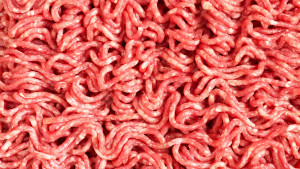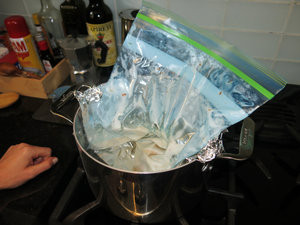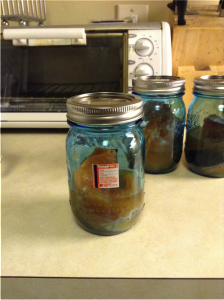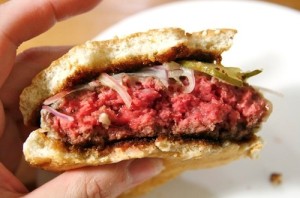Friend of the blog Don Schaffner of Rutgers University had some food safety concerns about a recent column broadcast by state-sponsored jazz radio station NPR about sous vide – or cooking under vacuum at a specific temperature.
 She (journalist T. Susan Chang) says:
She (journalist T. Susan Chang) says:
Maybe you’ve heard the stories about city health department officials forcing chefs to pour bleach on their sous vide meats. It’s a story that always makes me want to cry, but for years public health has relied on a firm food safety rule: dangerous germs live at between 40 and 140 degrees Fahrenheit. Even the pink interior of a medium-rare burger falls above this range, and most cooking techniques take place around or well above the boiling point of water (212 degrees F).
Schaffner says:
Some species of pathogenic bacteria can multiply between 40 and 140°F, and by multiply I mean increase in number. There are several species of pathogenic bacteria that can multiply slowly at temperatures less than 40°F. There are many, many pathogenic bacteria that can survive but not multiply at temperatures less than 40°F. All spore forming pathogenic bacteria can easily survive at temperatures more than 140°F. Some of these spores can survive boiling water, including the spores of Clostridium botulinum, which is of great concern because it can grow in vacuum packaged foods if the temperatures are in that 40 to 140° range for the right amount of time.
She says:
Aiming for that window — above 140 degrees for safety, below 150 degrees for texture — isn’t hard if you’re set up to control temperature within a degree or two. And you can pasteurize your protein by holding it there for long enough.
Schaffner says:
Taking food above 140°F does not make it safe. The U.S. Department of Agriculture’s Food Safety Inspection Service has a document which provides guidance to meat processors regarding safe cooking temperatures. That document is entitled “Appendix A Compliance Guidelines For Meeting Lethality Performance Standards For Certain Meat And Poultry Products”, and is available here: http://www.fsis.usda.gov/OPPDE/rdad/FRPubs/95-033F/95-033F_Appendix_A.htm. According to this document a food at 140 °F needs 12 minutes to meet the USDA standards. That same guidance also indicates that a food can meet the standards by heating at 130°F too, just for a much longer time, and even at 150°F more than a minute is needed.
She says:
Salmon is a perfect protein on which to test your newfound control. Allow the salmon to sit in this brine in the refrigerator as you bring the water bath of your sous vide up to your target temperature (115 for rare, 120 for medium-rare).
When the water bath has reached the target temperature, remove any excess air from the zip-top bag by displacement if you’re not using a vacuum-sealed bag. Drop the salmon into the bath. It should take about 1/2 hour to come to temperature.
Schaffner says:
Not likely to result in any significant pathogen reduction. Hitting the outside with a blowtorch will kill pathogens on the surface, but not any that are internalized.
She says:
Sous Vide Pork Belly, (when) cooked at 144 degrees for two days, the lean meat fibers sandwiched between the layers of fat stay plump and juicy.
 Schaffner says:
Schaffner says:
This will give significant pathogen reduction, but I worry about any process that takes two days. If there is a temperature failure, that is a lot of time for risk to develop.
She says:
Sous Vide Basic Burger, bring the water bath up to 120 for rare, 125 for medium-rare. Drop the bagged frozen patties in the bath (displacing any air pockets first); the meat will take about 1 1/2 hours to get to its target temperature.
Schaffner says:
Quite risky from my perspective. Pathogens will be internalized in these burgers, and even 125°F for 1.5 hours will not give a significant reduction.
She says:
Sous Vide Herbed All-Purpose Chicken Breast, bring the sous vide water bath up to 140 degrees. … You’ll need 1 to 1 1/2 hours to cook the chicken to the target temperature.
Schaffner says:
Probably safe.
Food safety can be complicated. While I share you passion for empowering people to innovate in the kitchen, I think it is important to get the science right, especially when it comes to food safety.
(Many thanks to Schaffner for continuing to share his infectious enthusiasm for all things microbiological – and getting it right).
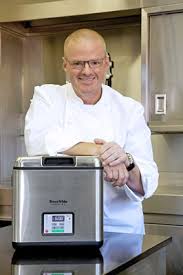 They found the ‘sous-vide’ method of simmering vacuum-packed foods in a water bath could increase the risk of food poisoning.
They found the ‘sous-vide’ method of simmering vacuum-packed foods in a water bath could increase the risk of food poisoning.
